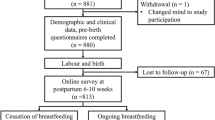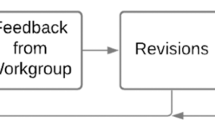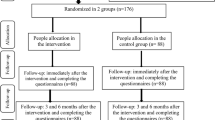Abstract
Study design
Narrative review.
Objectives
To evaluate the availability and quality of breastfeeding guidelines for women with spinal cord injury (SCI).
Setting
International Collaboration on Repair Discoveries (ICORD), Department of Medicine, Vancouver, BC.
Methods
An environmental scan restricted to English language literature was performed to identify existing postpartum and breastfeeding guidelines. Guidelines were evaluated using a structured, validated tool (AGREE II) by 13 appraisers [medical/research experts (n = 10) and those with lived experience (n = 3)] from Vancouver and two international sites. Seven guidelines were evaluated across Domain 1 of the AGREE II tool to determine if they were applicable to mothers with SCI/physical disabilities. Domains 2 to 7 were evaluated if the guideline made mention of the SCI population.
Results
Of the seven guidelines evaluated, only one mentioned SCI (Postpartum Care in SCI from BC Women’s Hospital). Other guidelines were excluded from further evaluation as they did not address the issue of breastfeeding in women with SCI. The overall scaled score for this guideline was 34.5%. There was significant variability between domains but no AGREE II domain scored greater than 50%, indicating substantial limitations.
Conclusions
Current breastfeeding guidelines are not targeted to persons with SCI. The one guideline that made mention of women with SCI had significant global deficits. This highlights the importance of developing guidelines for health care providers focused specifically on women with SCI to support and optimize breastfeeding in this unique population for the benefit of mother and infant across the lifespan.
Similar content being viewed by others
Log in or create a free account to read this content
Gain free access to this article, as well as selected content from this journal and more on nature.com
or
Data availability
Datasets for the current study are available from the corresponding author on reasonable request.
References
World Health Organization. WHO recommendations on postnatal care of the mother and newborn. 2014. https://www.ncbi.nlm.nih.gov/books/NBK190090/#:~:text=At%20least%20three%20additional%20postnatal,and%20six%20weeks%20after%20birth.&text=Home%20visits%20in%20the%20first,of%20the%20mother%20and%20newborn.
Dieterich CM, Felice JP, O’Sullivan E, Rasmussen KM. Breastfeeding and health outcomes for the mother-infant dyad. Pediatr Clin N Am. 2013;60:31–48.
Horta BL. Breastfeeding: investing in the future. Breastfeed Med. 2019;14:S11–12.
Horta BL, de Mola CL, Victora CG. Long-term consequences of breastfeeding on cholesterol, obesity, systolic blood pressure and type 2 diabetes: a systematic review and meta-analysis. Acta Paediatr. 2015;104:30–7.
Bartick MC, Stuebe AM, Schwarz EB, Luongo C, Reinhold AG, Foster EM, et al. Cost analysis of maternal disease associated with suboptimal breastfeeding. Obstet Gynecol. 2013;122:111–9.
Cowley KC. Breastfeeding by women with tetraplegia: Some evidence for optimism. Spinal Cord. 2014;52:255.
Bergmann RL, Bergmann KE, von Weizsäcker K, Berns M, Henrich W, Dudenhausen JW, et al. Breastfeeding is natural but not always easy: intervention for common medical problems of breastfeeding mothers – a review of the scientific evidence. J Perinat Med. 2014;42:9–18.
Stuebe AM, Meltzer-Brody S, Pearson B, Pedersen C, Grewen K. Maternal neuroendocrine serum levels in exclusively breastfeeding mothers. Breastfeed Med. 2015;10:197–202.
Liu N, Krassioukov AV. Postpartum hypogalactia in a woman with brown-séquard-plus syndrome: a case report. Spinal Cord. 2013;51:794–6.
Holmgren T, Lee AHX, Hocaloski S, Hamilton LJ, Hellsing I, Elliott S, et al. The influence of spinal cord injury on breastfeeding ability and behavior. J Hum Lac. 2018;34:556–65.
Kent JC, Prime Danielle K, Garbin C. Principles for maintaining or increasing breast milk production. J Obstet Gynecol Neonatal Nurs. 2012;41:114–21.
Crowley KC. Psychogenic and pharmacologic induction of the let-down reflex can facilitate breastfeeding by tetraplegic women: a report of 3 cases. Arch Phys Med Rehabil. 2005;86:1261–4.
Phillips AA, Krassioukov AV. Contemporary cardiovascular concerns after spinal cord injury: mechanisms, maladaptations, and management. J Neurotrauma. 2015;32:1927–42.
Wan D, Krassioukov AV. Life-threatening outcomes associated with autonomic dysreflexia: a clinical review. J Spinal Cord Med. 2014;37:2–10.
Jackson AB, Wadley V. A multicenter study of women’s self-reported reproductive health after spinal cord injury. Arch Phys Med Rehabil. 1999;80:1420–8.
Bertschy S, Geyh S, Pannek J, Meyer T. Perceived needs and experiences with healthcare services of women with spinal cord injury during pregnancy and childbirth—a qualitative content analysis of focus groups and individual interviews. BMC Health Serv Res. 2015;15:234.
National Spinal Cord Injury Statistical Center, Facts and Figures at a Glance. Birmingham, AL: University of Alabama at Birmingham; 2016. https://www.nscisc.uab.edu/Public/Facts%20and%20Figures%20-%202021.pdf.
Perinatal Services BC. Breastfeeding healthy term infants. May 2013, V3 March 2015. http://www.perinatalservicesbc.ca/Documents/Guidelines-Standards/HealthPromotion/BreastfeedingHealthyTermInfantGuideline.pdf.
Winnipeg Regional Health Authority. Breastfeeding practice guidelines for the healthy term infant. 2005. https://wrha.mb.ca/files/womens-health-breastfeeding-practice-guidelines.pdf.
Registered Nurses Association of Ontario. Breastfeeding best practice guidelines for nurses. 2003. https://rnao.ca/sites/rnao-ca/files/Breastfeeding_Best_Practice_Guidelines_for_Nurses.pdf.
Consortium for Spinal Cord Medicine. Sexuality and reproductive health in adults with spinal cord injury: a clinical practice guideline for health-care professionals. J Spinal Cord Med. 2010;33:281–336.
National Institute for Health and Care Excellence. Postnatal care (QS37). 2013. https://www.nice.org.uk/guidance/qs37.
BC Women’s Hospital and Health Centre. Postpartum care for women with spinal cord injury. 2017. http://policyandorders.cw.bc.ca/resourcegallery/Documents/BC%20Women’s%20Hospital%20%20Fetal%20Maternal%20Newborn/WW.03.22.D%20Postpartum%20Care%20for%20Women%20with%20Spinal%20Cord%20Injury%20(SCI).pdf.
Health Canada, Minister of Public Works and Government Services. Family-Centred Maternity and Newborn Care: National Guidelines. 2000. http://publications.gc.ca/collections/collection_2020/sc-hc/H39-527-2000-eng.pdf.
The AGREE Collaboration. Development and validation of an international appraisal instrument for assessing the quality of clinical practice guidelines: the AGREE project. Qual Saf Health Care. 2003;12:18–23.
AGREE Next Steps Consortium. The AGREE II Instrument [Electronic version]. 2009. http://www.agreetrust.org.
Brouwers MC, Kho ME, Browman GP, Burgers JS, Cluzeau F, Feder G, et al. AGREE II: advancing guideline development, reporting and evaluation in healthcare. CMAJ. 2010;182:E839–42.
Brouwers MC, Kho ME, Browman GP, Burgers JS, Cluzeau F, Feder G, et al. Development of the AGREE II, part 2: Assessment of validity of items and tools to support application. CMAJ. 2010;182:472–7.
Randolph JJ. Free-Marginal Multirater Kappa (multirater κfree): an Alternative to Fleiss’ Fixed-Marginal Multirater Kappa. In: Joensuu Learning and Instruction Symposium, Vol. 2005. Joensuu, Finland: University of Joensuu; 2005.
Landis JR, Koch GG. The measurement of observer agreement for categorical data. Biometrics. 1977;33:159–74.
Acknowledgements
Dr. Andrei Krassioukov holds the Endowed Chair in Rehabilitation Medicine, University of British Columbia, and his research is supported by: Canadian Institutes of Health Research (CIHR), Heart and Stroke Foundation of Canada (Heart and Stroke Foundation), International Spinal Research Trust (Spinal Research), Wings for Life (Wings for Life Research Foundation), Canadian Foundation for Innovation, BC Knowledge Development Fund, PRAXIS Spinal Cord Institute, and International Collaboration on Repair Discoveries (ICORD).
Funding
This research was supported by the Craig H. Neilsen Foundation (Sustainable Impacts Project, Creating Opportunity & Independence 590116, PI Dr. Andrei Krassioukov) and CIHR (Canada Graduate Scholarship – Masters Program, Amanda Lee). The funders had no influence on the study design, results, and interpretation of findings.
Author information
Authors and Affiliations
Contributions
The research question and procedure were conceived by AVK. Appraisers included SE, AHXL, LM, SH, KH, IZ, CAR, PM, AG and AVK. SE, AK, AHXL, TM, RCKC, and LM provided feedback on drafts of the manuscript. LR, TM and RCKC drafted the manuscript and analyzed the data.
Corresponding author
Ethics declarations
Competing interests
The authors declare no competing interests.
Ethical approval
Ethical approval was not obtained as this is an assessment of guideline quality and does not request any personal information from the appraisers.
Additional information
Publisher’s note Springer Nature remains neutral with regard to jurisdictional claims in published maps and institutional affiliations.
Supplementary information
Rights and permissions
About this article
Cite this article
Rosetti, L., Elliott, S., Lee, A.H.X. et al. The availability and quality of breastfeeding guidelines for women with spinal cord injury: a narrative review. Spinal Cord 60, 837–842 (2022). https://doi.org/10.1038/s41393-022-00805-x
Received:
Revised:
Accepted:
Published:
Issue date:
DOI: https://doi.org/10.1038/s41393-022-00805-x



